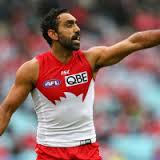- About Us
- Columns
- Letters
- Cartoons
- The Udder Limits
- Archives
- Ezy Reading Archive
- 2024 Cud Archives
- 2023 Cud Archives
- 2022 Cud Archives
- 2021 Cud Archives
- 2020 Cud Archives
- 2015-2019
- 2010-2014
- 2004-2009
 |
Goodes Moves |
During the Australian winter four football codes compete for public attention. What we call soccer and is known as football throughout the world gathered strength during the period of postwar European immigration. Rugby union was traditionally associated with upper middle class schools. Rugby League was the professional, working class game. Aussie Rules was strongest in the southern states – everywhere but Queensland and New South Wales really. Recent decades have seen significant changes in the administrations of all the codes. Each now has a national focus and sides have lost their local identities which have been replaced by franchises. The effect of these changes is a matter for debate, but it certainly places the codes into a comparative framework.
Australia’s Indigenous men and women have been prominent in various sports. Indigenous men have made great contributions to all four football codes. However, Aussie rules, now know as AFL or the Australian Football League has been most prominent in recruiting Indigenous players and developing the sport in remote areas. When Aussie Rules was dominated by the strong Melbourne competition, Victorian clubs were quick to spot talent and provide opportunities for Indigenous players from North Queensland and the Northern Territory.
The AFL’s decision to hold a special round of matches dedicated to Indigenous players, spectators and other participants in the sport deserves the support of all Australians. One wise Aboriginal uncle said recently that all the talk of racial tolerance is really misguided. Reconciliation would be better served when we learned to appreciate each other better and that means appreciating the ways we differ as well as the ways we are similar. Greater appreciation is simple to achieve – it is a matter of willing ourselves to it. The Indigenous round of matches gives everyone the opportunity to express their appreciation, and indeed to practise it in a very easy manner.
Indigenous Australians have many great role models. It is important to remember also that these role models are not just for Aboriginal people, but for all Australians, especially for those who admire people who achieve in any field without the advantages of birth that others may have. If you think of great Indigenous Australians, their greatness is not measured in narrow values but in broadly human ones.
Among the greatest role models on display in the Indigenous round was the highly decorated Adam Goodes, a veteran with the Sydney Swans. Over the years, Goodes has shown himself to be aware of any negativity displayed towards himself and other Indigenous players, and fearless in standing up for respect and human rights. He has always done this with dignity but without compromise.
During the match against Carlton, Goodes expressed the emotion of the game in a highly unusual and very special manner. He headed towards Carlton spectators doing what might be described as a war dance, or at least the kind of dance which often substitutes for war. The reaction of some people was predictably hostile. Their criticism of Goodes was predictable because it seems highly likely that they are opposed to Indigenous advancement at any cost. Thinking of themselves as belonging to elites created by the current system they would be very discomforted were Indigenous people to gain their deserved share of Australia’s resources and their deserved share of political power. Opponents of Indigenous advancement know that the Indigenous round is a great opportunity for all Australians to view Aboriginal players and to appreciate their skills. They must feel threatened and alarmed by such positive developments. Thankfully, criticism of Goodes’ moves came from a very small minority of people, most of whom might be described as constant critics of Indigenous Australians.
Certainly, Goodes has had his supporters in the Australian media. There did not seem to be any expression of support from ‘Lifestyle Tony’, self-appointed Minister for Aboriginal affairs, but perhaps media have not thought such comments newsworthy.*

One comment that seems to have been missing however, concerns the quality of Goodes’ dance. The grace and ease with which he performed was outstanding. He glided over the turf and his movements were very expressive. He displayed skills which would not be out of place in any modern dance company. Perish the thought of his critics being able to display their feelings in any style which would not make immediately obvious their lack of any cultural understanding of their own. The mind boggles trying to imagine the impoverished exhibition! Nor should we waste any time on such unlikely imaginings.
Perhaps Goodes’ moves made such an impression because he does not do it every week. The ‘dance’ was, however, so fluid and rhythmical that it was both watchable and inspiring. It provided the kind of moment which sends goosebumps up the spine. It would make a perfect counter to the powerful haka performed by New Zealand’s national teams. Rather than denigrate Goodes for his dance, we should be asking him for cultural permission to spread it around Australia.
*Prime Minister Tony Abbott recently defended the removal of funding to remote communities by saying we could not support 'lifestyle choices'.
A former academic, Tony Smith has written extensively on a wide range of subjects as diverse as folk music and foreign policy issues in the Australian Review of Public Affairs, the Journal of Australian Studies Review of Books, Overland, the Australian Quarterly, Eureka Street, Online Opinion and Unleashed.
